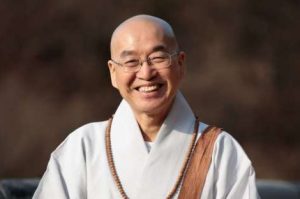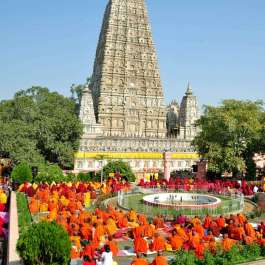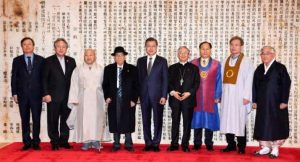Nestled in the western Gorkha District of Nepal’s Gandaki Province lies one of the country’s lesser-known jewels: Tsum Valley. This ancient Buddhist region, bordering Tibet, boasts a long history of Dharma practice. Today, the valley stands as a protected refuge where time-honored Buddhist traditions continue to thrive amid breathtaking Himalayan landscapes. Officially opened to foreign tourists in 2008, this once-secluded region now faces the challenge of balancing the conservation of its rich cultural and spiritual heritage with the growing influx of modern tourism.
The Mahayana and Vajrayana traditions of the Himalayas are deeply embedded in Tsum Valley, as evidenced by the unique and historic Buddhist temples, monasteries, and other sacred landmarks that punctuate the rugged landscape. Among them: Rachen Gompa, standing on a scenic plateau in the lap of the valley, beneath the revered cliff-face grotto in which the great Tibetan siddha Milarepa himself is believed to have meditated.
It is here that a remarkable project to protect and conserve this ancient heritage—the Tsum Preservation Project—is taking place for the benefit of the local communities, for the benefit of Nepal’s precious Buddhist heritage, and for the benefit of sustaining these ancient expressions of the Buddhadharma for posterity.
The Tsum Preservation Project is led by Treasure Caretaker Training (TCT), a US-headquartered non-profit organization dedicated to working closely with nuns and monks to help ensure the preservation of the world’s remaining authentic Buddhist treasures and relics. TCT is led by professional conservator Ann Shaftel, a fellow of the International Institute for Conservation and the American Institute for Conservation, and a member of the Canadian Association of Professional Conservators. Since 1970, Ann has worked on the conservation of Buddhist art across the world, cooperating with monasteries, Dharma centers, museums, and universities.
Part four of this series of articles on the Buddhist heritage of Tsum Valley recounted my second visit to Tsum Valley in May 2024. I joined Ann and her dedicated multinational team of conservators from TCT for the latest phase of the Tsum Preservation Project at Rachen Gompa, which focused on an extensive collection of molded clay votive offerings, known in Tibetan as tsa-tsas, depicting the bodhisattva of compassion Avalokiteshvara (Tib: Chenrezig).
Also known as Rachen Nunnery, Rachen Gompa stands serenely on a picturesque plateau in Tsum Valley at an elevation of 3,240 meters. Embraced protectively by imposing mountain cliffs on either side. This expansive and growing monastery is home to a community of devoted female monastics, led by the abbot, respected Buddhist scholar and teacher Geshe Tenzin Nyima.
Rachen Gompa was established 88 years ago in 1936 by the Bhutanese lama Drupa Rinpoche. In 2005, the present Drupa Rinpoche requested Lama Zopa Rinpoche to oversee the welfare of the two monastic communities, who were living in difficult circumstances at the time. Lama Zopa Rinpoche subsequently assigned Kopan Monastery, a flourishing monastery just outside of the Buddhist enclave of Boudha in the Kathmandu Valley, to take over the administration of the two communities.
Rachen Nunnery offers the women of Tsum Valley a unique opportunity to dedicate themselves to spiritual study and practice, as an alternative to their traditional roles as wives and mothers. Today, the gompa is home to some 36 nuns—from children to the very elderly—led by Geshe Tenzin Nyima. Their lives at the nunnery primarily center on studying Tibetan Buddhism and engaging in spiritual practices. Additionally, they provide secular education for the youngest nuns and play a crucial role in preserving Buddhist traditions in the region.
As well as being closely involved with the conservation work, Geshe-la is also overseeing the construction of what will become a striking new landmark for the valley within the gompa compound—a World Peace Stupa that, once completed, will stand some 21 meters tall, towering above Rachen Gompa’s single-level buildings.
Although our visit to Rachen Gompa, which took place during the Tibetan new year, Gesha-la was always generous with his time and attention, judiciously providing help, guidance, and wisdom, wherever and whenever needed.
BDG: Geshe-la, could you talk a little about your background before you came to Tsum Valley?
Geshe Tenzin Nyima: Although I’ve lived in Tsum Valley for about 12 years now, my family are originally from Tibet. I became a monk in Tibet when I was very young. I left my home country in 1989, and because I was unable to return I traveled to Sera Monastery in India to study. Now I’m 54 years old.
This nunnery was offered to Lama Zopa Rinpoche of Kopan Monastery, who is my teacher, and he sent me here to Rachen Gompa after I had completed my geshe degree. Before Lama Zopa Rinpoche, the gompa was the responsibility of the Bhutanese lama Drupa Rinpoche.
Both this nunnery and Mu Gompa [higher up Tsum Valley, for male monastics] were established by Drupa Rinpoche, and both were offered to Lama Zopa Rinpoche to oversee. When I first came to Tsum 12 years ago, there were about 22 monks in Mu Gompa.
BDG: What was the decision that brought you to the monastic life?
Geshe Tenzin Nyima: I became a monk for traditional cultural reasons; when a family has several sons, the youngest often goes to the monastery—which was the case with me. Also, my father passed away when I was young, and one of his requests was that one of his sons should pursue monastic ordination.
Because of the Chinese occupation of Tibet, it wasn’t easy to become a monk at that time. Later, after the Chinese authorities began to relax their restrictions in Tibet, I was able to enter a monastery.
BDG: What was your original monastery?
Geshe Tenzin Nyima: The monastery is called Thukja Gompa, a sacred place associated with the tantric deity Palden Lhamo, the protector of Tibet.
BDG: You’ve been here in Tusm valley for 12 years, and you’ve helped to modernize Rachen Gompa for the benefit of the nuns and the surrounding communities. What are your aspirations for Rachen Gompa and for yourself as a Buddhist monastic?
Geshe Tenzin Nyima: One of my main preoccupations is to continue the social engagement activities of Rachen Gompa—our interactions with the local communities in Tsum Valley, which means offering social services as well as regular pujas and spiritual practices, and helping the local population gain a better understanding of the Buddhadharma.
For myself, I hope that I can help to manifest the wish of His Holiness the Dalai Lama and Lama Zopa Rinpoche to ensure the longevity of the Buddhadharma among the peoples of the Himalaya, so I wish to work to embody their great aspiration.
BDG: When was the decision made to undertake heritage conservation work at gompa?
Geshe Tenzin Nyima: Well, we received instructions from Drupa Rinpoche, the reincarnation of the lama who established Rachen Gompa and Mu Gompa. It had been a long time since any work was done here. Last year, we began restoring and repainting some of the larger statues, with assistance from the local lay community.
BDG: This is not an insignificant undertaking, working within the walls of a consecrated shrine room. It’s something that must be carried out with a great deal of care.
Geshe Tenzin Nyima: The great Tibetan master Je Tsongkhapa [c. 1357–c. 1419] undertook a number of notable activities in his life that are still remembered today. At one time during his travels he came to a place where there was a large statue of Maitreya Buddha. It had been standing for many years and so had fallen into state of disrepair. Upon seeing the statue, Je Tsongkhapa set about cleaning and repairing the image. This was just one of the activities of Je Tsongkhapa, who established our Dharmic lineage, and it was of great significance. Likewise, in carrying the heritage conservation work we are performing in the shrine room here, we are doing something very similar!
Among the great activities noted in the biography of Je Tsongkhapa was his establishment of Ganden and Sera monasteries, and the cleansing of the statue of Maitreya Buddha. After restoring the statue, Je Tsongkhapa reconsecrated that statue by inviting deities or wisdom beings (Tib: yeshepa) into the image. Among the people present for that ritual, those who had favorable karma were even able to observe the deities arriving.
Q. It hasn’t been necessary to take similar steps in this instance?
Geshe Tenzin Nyima: The wisdom beings are still in here in the shrine room. For the purposes of our work here, cleaning the tsa-tsa’s and the area, deconsecration is not really necessary. Although it might be better to do so—especially if there were items that were so badly damaged that they needed to be disposed of. In such cases, we would send the deities away. But since we are only cleaning, it’s not completely necessary to do so.
However, when we talk about big statues, kept in high places, they often don’t receive enough care and they can become damaged over time. If we need to repair them, then we would conduct the necessary rituals.
There’s a famous Tibetan story: a man was traveling through a desert when he spotted a clay tsa-tsa of the Buddha just as it was about to rain. The man thought to himself, “Oh, it’s about to rain and if the tsa-tsa gets wet it’s going to be damaged.” And so he picked up a pair shoes and used them to cover the tsa-tsa of the Buddha to protect it against the rain.
A short while later, another person passed by. He saw the tsa-tsa beneath the shoes and was shocked, wondering who would dare to cover the Buddha with a pair of shoes, and so he removed them before continuing on his journey.
We might wonder which of these two men gained merit in this situation. And the answer is that they both did! The important point was their intention—they both wanted to protect the statue. That’s how it works!
BDG: Are there any special plans for the Rachen Gompa once the conservation work is completed?
Geshe Tenzin Nyima: Drupa Rinpoche established some guidelines for pujas and offerings that we need to perform throughout the year, so this schedule will be strictly maintained. The heritage conservation work means that we’ll soon be able to resume conducting these pujas in the old temple building as well as in the larger, newer temple.
We also plan to build a formal meditation center, which will be inside the new stupa once it’s completed, as well as using the old temple. As this monastery is an important center for the people of Tsum, every year, we will invite lay practitioners from the local community to receive foundational teachings on Buddhism and Buddhist practice in the three spaces—the new shrine room, the old shrine room, and inside the new stupa.
BDG: Geshe-la, I have one final question, if I may. The audience of BDG is comprised of practitioners of various Buddhist traditions and numerous nationalities and cultures. Would you mind sharing a short teaching or piece of wisdom for their benefit?
Geshe Tenzin Nyima: As Buddhists, our priority should be to generate merit, and the way we generate merit is through benefiting others. We often speak of benefiting all sentient beings, but very often it’s difficult or impossible for us to act in a way that benefits all sentient beings. So what we should do is offer our compassionate support to those who are near to us or with whom we are in contact—to help them, to support them. And if we can do so, then we come closer to embodying the teachings of the Buddha.
Whoever and wherever you are in your community, your locality, and your country, be helpful, be supportive, and be compassionate. Your practice begins where you are.
When you live with this kind of altruistic mentality, even if your own life is difficult, this will bring you happiness. So let your life be led by this altruistic mindset!
BDG: Thank you Geshe-la for facilitating this heritage conservation work and for sharing your time with us!
See more
Treasure Caretaker Training: The Preservation of Buddhist Treasures Resource
Related features from BDG
Buddhism in the Hidden Valley, Part 1: An Ancient Heritage in Tsum
Buddhism in the Hidden Valley, Part 2: Heritage Conservation in Tsum
Buddhism in the Hidden Valley, Part 3: An Interview with Khenpo Karma Samdup on the Legacy of Kenchen Thrangu Rinpoche
Buddhism in the Hidden Valley, Part 4: Conservation and Community at Rachen Gompa
Related videos from BDG
Buddhist Heritage: Conservation and Creation (BDG YouTube)































Am Buddhism following and Buddhist stady running at India